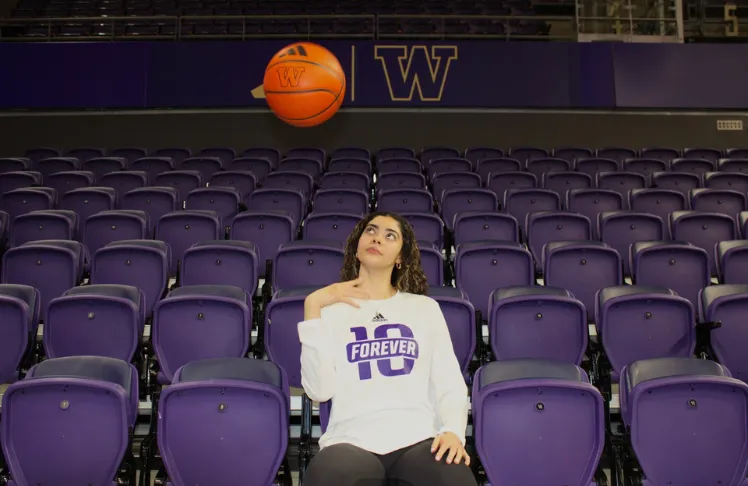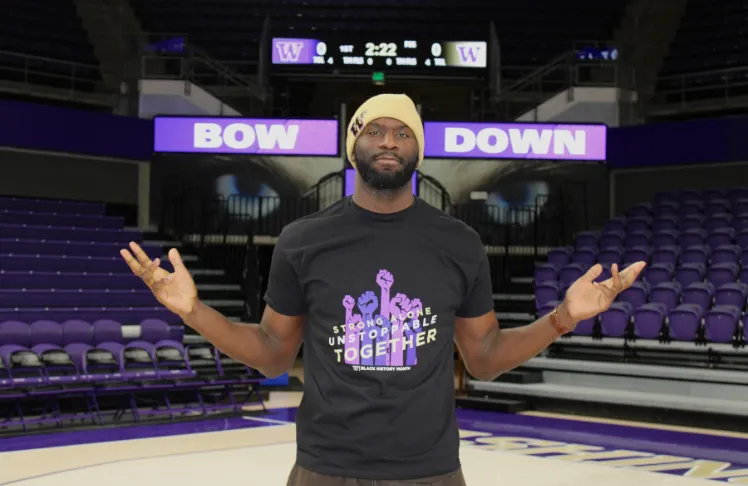By Madison Rogers and Nicholas Williams, The Seattle Medium
When you see the Huskies on the court this February, they won’t be wearing their usual warm-up attire.
In honor of Black History Month, forward Dalayah Daniels and center Franck Kepnang, two Husky basketball players, designed warm-up shirts for their teams— spreading a message of community and activism.
The warm-up shirts, sponsored by Adidas, were paid for by the University of Washington’s Athletics Department.
Fans could end up with one of their own with T-shirt tosses during games on Feb. 8 for the men’s team and Feb. 20 for the women’s – in honor of UW’s Black History Month.
Daniels, a homegrown talent from Garfield High School, and Kepnang, originally from Yaoundé, Cameroon, said they couldn’t personally identify with the apparel given to them for Black History Month in the past.
“This just felt more like creating something that we think is cool and we want to wear. It’s nice for once to be the designer for what we all want to wear,” said Kepnang.
This initiative, led by the Black Student Athlete Alliance (BSAA), will be the first time ever student athletes from the basketball teams were asked to design shirts for Black History Month, according to the athletes.
BSAA aims to unify the communities associated with Black athletes at the University of Washington. Athletes get the opportunity to share information about Black businesses, promote on-campus Black organizations, learn about professional opportunities and celebrate the success of Black student athletes.
In 2023, BSAA won the Student Athlete Group of the Year Award at the Black Student Athlete Summit in Los Angeles, hosted by the University of Southern California (USC).
This year’s warm-up shirt project originated when Donovan Wilson, the university’s Big Ten Fellow in Diversity, Equity, and Inclusion (DEI), had conversations with other DEI staff. Wilson then reached out to the BSAA board members to design the shirts.
Wilson oversees the BSAA, helps out with heritage months, oversees community engagement initiatives and works with student athletes in professional and personal development. Each Big Ten school gets a fellow in the athletics department.
“I think the shirts are another piece to really amplify Black history and what the month is. I think people know it’s Black History Month but it’s very easy to get caught up in the day to day and in the mundane things that happen,” Wilson said. “Also, basketball being a predominantly Black sport, I think that highlights and amplifies representation.”
The shirts represent something much larger: a statement of unity, visibility, and legacy.
“I think the shirts remind us that we’re a lot stronger together than we are apart. We hear that all the time, but numbers have power,” said Daniels.
Kepnang agrees and believes these shirts create a sense of togetherness.
“When everybody is wearing it, everybody needs to be on the same page. All of us wearing that shirt, both men’s and women’s teams, just shows the solidarity among all of us,” said Kepnang.

Daniels wanted to create something that didn’t just speak to the present but also appreciated the Huskies who came before her.
“I feel like the month of February is a good reminder that it’s more than just a win, it’s bigger than that,” Daniels said. “ It’s about our history. It’s about the people who wore uniforms before us, the Black student athletes who were before us.”
The black shirt features multiple fists, all with varying shades of purple, a nod to the University of Washington’s signature color, but also a symbol of inclusivity and diversity.
Daniels said the varying shades of purple represent how her teammates and peers can be supportive of Black history, even at a predominantly white institution.
Along with the colors, the shirt’s bold wording and raised fists are images often associated with African American activism and resilience.
“The wording sends a message right in the middle, straightforward,” Kepnang said. “The different fists are something that will stick in your brain and make an impression. I think fists symbolize something bigger than ourselves.”
The union and message the shirts create along with the platform student athletes have, underscores the importance of representation in sports. Sports can often transcend barriers and create change.
“I think there is power in being a student athlete and being able to lead this initiative,” Wilson said. “When you see a lot of these activism movements, especially on college campuses, if it’s led by student athletes, I feel like there’s more attraction to it and power in it.”
Daniels said student athletes have a platform and voice that other students on campus don’t. She feels student athletes should seize the opportunity to speak up on topics they’re passionate about.

Kepnang emphasizes that sports bring people together. It’s one of the best places to raise awareness, making a mark on future generations.
“For all the little boys and girls growing up, I hope they can see us as role models and obviously we are doing this kind of awareness for the next generation,” Kepnang said. “So that as they grow up, they can come in and make a better world for all of us.”
For Wilson, the efforts of Black History Month are not just a one-month initiative, but instead the groundwork for a yearlong effort.
“We need to embed DEI into all aspects of our athletics department, not just doing the heritage month, but ensuring that our Black student athletes feel safe, heard and valued, even outside of their season,” said Wilson.
Wilson wants to continue giving athletes the platform to share their stories, backgrounds and perspectives. In the future, he plans to do more creative elements for all heritage months, and bridge the gap with those communities within athletics.
The warm-up shirts are not just a fashion choice on the court, but an important part of a larger message during Black History Month from two of the University of Washington’s own.
“I would just urge people to come together. People have to learn from one another, learn from someone with a different background or a different experience,” Kepnang said. “Don’t be afraid to open your heart and listen to them. Be open to learning something that’s a little different from what you grew up with, and be able to have open discussions with people you disagree with.”
Source: Seattle Medium